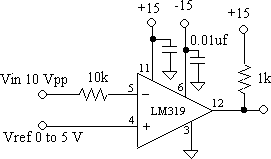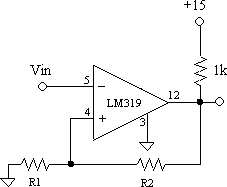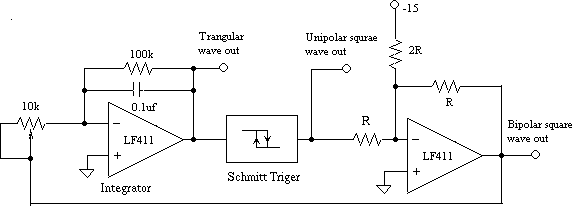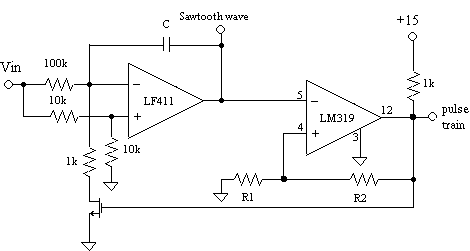COMPARATORS AND WAVEFORM GENERATORS
The purpose of this lab is to become acquainted with the use of comparators
and the use of comparators with hysteresis (Schmitt triggers) for waveform
generation. We will use the LM319 dual-comparator integrated circuit. The
LM319 contains two specially-designed, fast comparators in one dual-in-line
package. The output of each comparator is high or low depending on whether
the difference between the two inputs is greater than or less than zero.
(An op-amp without feedback also behaves as a comparator, but is not suitable
for high-speed operation because of slew rate limitations. How long would
it take the output of a 741 Amplifier to switch between +10 and -10 volts?)
- Construct the following simple comparator circuit and investigate how
the output and input waveforms are related as the reference level is varied.
- Sketch or plot a typical set of waveforms. Is this an inverting or
non-inverting comparator?
- Observe and record the switching speed with a 1X scope probe, for both
positive and negative output transitions.
- Why is one of the switching speeds slower than the other?
- Why does a 10X probe fix the problem?
- Does the switching speed now vary with the input frequency, and why?

- The comparator can be given hysteresis by providing some positive feedback,
as below (section 12.4). (This circuit is called a Schmitt trigger, and
is widely used in digital circuits to prevent multiple output transitions
as a noisy input signal passes through the reference voltage.)
- Choose resistor values in the feedback to give a hysteresis levels
of about 0 and 1.5 volts.
- Construct the circuit and sketch the hysteresis curve (vout
vs. vin).
- Explain why the switching levels are what they are.
- How does the switching speed now vary with input frequency, and why?

- The Schmitt trigger can be used to construct a relaxation oscillator
as shown below. This circuit produces a triangle wave and unipolar and
bipolar square waves.
- Construct and test the circuit and explain how it operates.
- Explain why the offset plus inverting amplifier is needed after the
Schmitt trigger.
- Modify the oscillator circuit to have a fixed frequency of 1 kHz, and
compare the observed and theoretical results.
- Finally, explain why the waveforms do not have a 50% duty cycle, and
how would you change the circuit to give a 50% duty cycle.

- Voltage Controled Oscillator. The Schmitt trigger can also be used with a current source to produce
a sawtooth or triangle wave, as discussed in class.
- Design and build the following sawtooth-wave generator. The input is a
positive DC voltage
- Design the Schmitt trigger so the input threshold levels will be 0
V and 5 V.
- Choose components so the frequency of oscillation will be 5 kHz for
an input voltage of 10 V.
- Determine the frequency of oscillation as a function of input voltage.
- Change the 1 k resistor so the output is a triangular wave.

© Copyright 1997 New Mexico Institute of Mining and Technology



